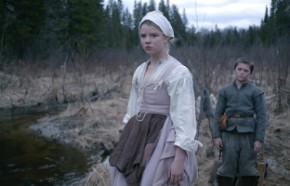Theological horror

Imagine that it’s 1630, and you’re in a Puritan Sunday school somewhere in New England. “Children,” the teacher says solemnly, “have you heard tell of the prideful man who cast aside God’s holy church and the bonds of Christian community to follow his own prideful ways, taking his wife and young children into the wilderness to set himself up against God’s chosen people?” In the movie The Witch (Robert Eggers’s directorial debut), what happens next is pretty much what you might imagine: the prideful man and his family are torn apart by forces of evil that inhabit the woods on the edge of the known world.
All the clichés about witches are here: old hags prey on innocent babies, while sexual temptresses suck the life out of young men. There are animal possessions, midnight naked dances around roaring flames, and suspicions that narrow in on the virginal teenage daughter. But The Witch doesn’t focus on shock or gore; instead it’s visually stunning and completely engrossing—and a true thriller, giving us more suspense than horror.
Read our latest issue or browse back issues.
Back in their European villages people told each other folktales about the dangers of wandering outside the boundaries of civilization. Civilization was a shaky concept in the hardscrabble lives of these 17th-century American settlers, and the folktales fit their circumstances and expressed their fears. The stories reinforced the notion that if they dared to step outside the known world, they risked both physical and moral destruction.
The folktales that are so rivetingly presented in The Witch are about both social life and the dangers of supernatural evil. The film captures the Calvinist sensibility of early Puritan New England, where self-scrutiny and despair are balanced with joy and confidence in the merciful providence of God (until evil overwhelms all emotions).
The portrait is theologically realistic if not historically accurate. Puritan families did not live in exile on the edge of hostile territory; they experienced more joy in everyday life than the viewer sees in the fear-soaked atmosphere of a horror movie. But the horror genre also shows us how Puritan Calvinism was intimately entwined with witchy folktales. The fear of witches went hand in hand with the Calvinist God whose inscrutable will predestined some to hell. Outside the bounds of grace, evil proliferates, and the boundaries of civilization are mirrored by the boundaries of God’s predestination.
About halfway through The Witch, the distraught oldest son begs his father to reassure him that his baby brother is in heaven even though he died without being baptized. Sticking to his Calvinist guns, the father can’t do it. But he expresses such tender love for his son and such hope in God’s providence that predestination almost seems like the “joyful doctrine” that Calvin wanted it to be.
This is also the moment in a horror movie when the main character assures someone that everything is going to be all right. When the son heads into the woods alone, we know what’s coming next. The fact that the son’s eternal soul is up for grabs raises the stakes, and makes for a great horror movie.
However far removed horror films are from real life, they are also about the ordinary world. Genre movies, like folktales, teach us lessons about evil, moral boundaries, personal integrity, and community. Though few viewers may believe in witches or a Puritan God, the human impulse to project perceived wrongs onto “evil others” is still with us. The Witch explores these impulses.
The theology in a horror movie probably won’t ever be rich enough or nuanced enough to satisfy someone trained in the subject. But horror movies can show us how theological ideas escape the control of churches or theologians and take on a life of their own. The Witch depicts a world teeming with theological imagination. When we experience the power of its folktales, we better understand why they have such a formidable hold on our imagination. We realize that theology is at work in our imaginative cinematic fables.






